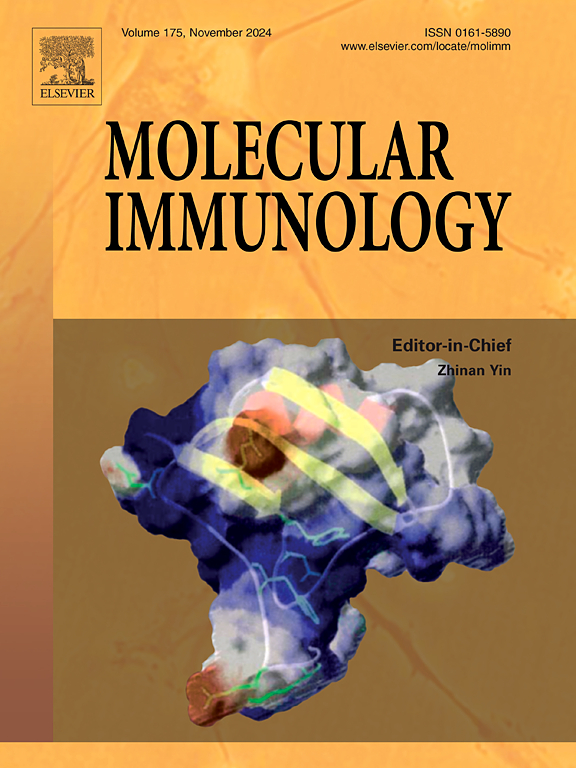Sigmoidin B通过ezh2 - akt2介导的小胶质细胞极化调节减轻败血症相关脑病
IF 3
3区 医学
Q2 BIOCHEMISTRY & MOLECULAR BIOLOGY
引用次数: 0
摘要
目的zeste同源物增强剂(EZH2)是治疗脓毒症的潜在靶点。本研究旨在基于中药数据库YaTCM筛选一种新型EZH2降解剂。这可能为开发治疗败血症相关脑病(SAE)的新药提供重要线索。方法采用巨噬细胞特异性敲除EZH2小鼠,观察EZH2对脓毒症小鼠存活率、炎性细胞因子、S100B、CD86、CD206水平的影响。基于MS177的结构,采用大规模虚拟高通量筛选筛选出Sigmoidin B作为新型EZH2降解物。采用分子动力学模拟和MMGBSA分析方法评价了Sigmoidin b的稳定性和结合特性,并通过体内和体外实验验证了MS177和新型EZH2降解剂的保护作用。结果巨噬细胞特异性敲除EZH2可提高脓毒症小鼠的存活率,降低CD86和TNF-α水平,促进IL-10和CD206的表达,减轻脑损伤程度。Sigmoidin B与EZH2具有较强的结合亲和力,具有类黄酮核心结构和烯烃侧链。分子验证实验证实,Sigmoidin B可通过EZH2-AKT2通路改善认知功能障碍并调节小胶质细胞极化。值得注意的是,与MS177相比,Sigmoidin B在缓解炎症方面表现出更好的疗效。结论成功筛选到天然化合物Sigmoidin B,确定其为新型EZH2降解物,是开发新型SAE治疗药物的潜在靶点。本文章由计算机程序翻译,如有差异,请以英文原文为准。
Sigmoidin B attenuates sepsis-associated encephalopathy through EZH2-AKT2-mediated regulation of microglial polarization
Purpose
Enhancer of zeste homolog (EZH2) is a potential target in treatment of sepsis. The current study is aimed to screen a novel EZH2 degrader agent based on the Traditional Chinese Medicine Database YaTCM. This may provide an important clue for development of new drugs to treat sepsis-associated encephalopathy (SAE).
Methods
Macrophage-specific EZH2 knockout mice were used to observe the effects of EZH2 on the survival rate, levels of inflammatory cytokines, S100B, CD86, and CD206 in sepsis mice. Sigmoidin B was screened as the novel EZH2 degrader based on the structure of MS177 using large-scale virtual high-throughput screening. Molecular dynamics simulations and MMGBSA analysis were used to assess the stability and binding characteristics of Sigmoidin B. The protective effect of MS177 and the novel EZH2 degrader were verified using in vivo and vitro experiments.
Results
Macrophage-specific knockout of EZH2 had been shown to enhance the survival rate in mice with sepsis, reduce levels of CD86 and TNF-α, promote the expression of IL-10 and CD206, and mitigate the extent of brain injury. Sigmoidin B exhibited strong binding affinity to EZH2 and featured a flavonoid core structure along with an olefin side chain. Molecular validation experiments confirmed that Sigmoidin B could ameliorate cognitive dysfunction and modulate microglial polarization via the EZH2-AKT2 pathway. Notably, Sigmoidin B demonstrated superior efficacy compared to MS177 in alleviating inflammation.
Conclusion
Natural compound Sigmoidin B was successfully screened and confirmed as a novel EZH2 degrader, which was a potential target for the development of new therapeutic for SAE.
求助全文
通过发布文献求助,成功后即可免费获取论文全文。
去求助
来源期刊

Molecular immunology
医学-免疫学
CiteScore
6.90
自引率
2.80%
发文量
324
审稿时长
50 days
期刊介绍:
Molecular Immunology publishes original articles, reviews and commentaries on all areas of immunology, with a particular focus on description of cellular, biochemical or genetic mechanisms underlying immunological phenomena. Studies on all model organisms, from invertebrates to humans, are suitable. Examples include, but are not restricted to:
Infection, autoimmunity, transplantation, immunodeficiencies, inflammation and tumor immunology
Mechanisms of induction, regulation and termination of innate and adaptive immunity
Intercellular communication, cooperation and regulation
Intracellular mechanisms of immunity (endocytosis, protein trafficking, pathogen recognition, antigen presentation, etc)
Mechanisms of action of the cells and molecules of the immune system
Structural analysis
Development of the immune system
Comparative immunology and evolution of the immune system
"Omics" studies and bioinformatics
Vaccines, biotechnology and therapeutic manipulation of the immune system (therapeutic antibodies, cytokines, cellular therapies, etc)
Technical developments.
 求助内容:
求助内容: 应助结果提醒方式:
应助结果提醒方式:


